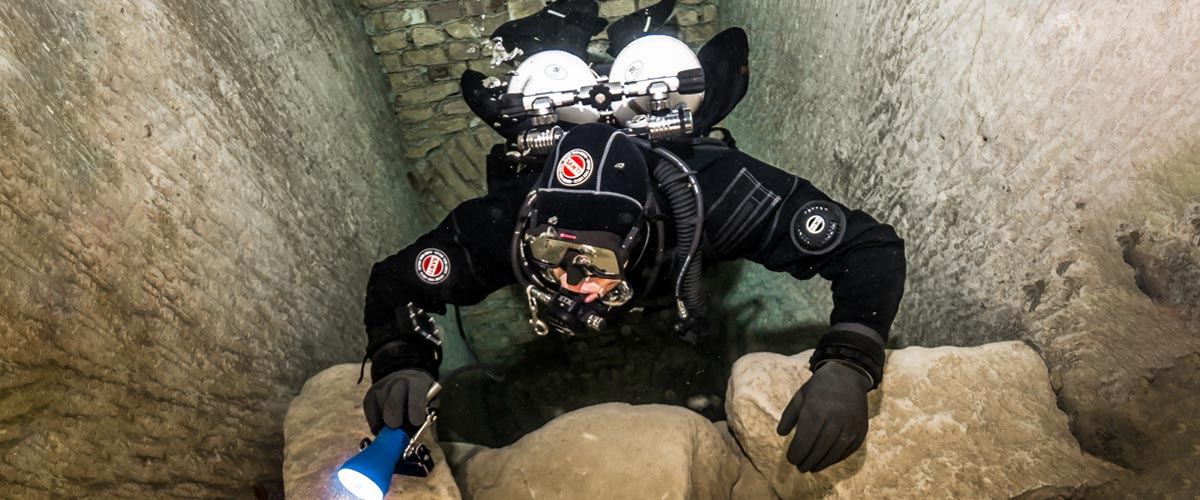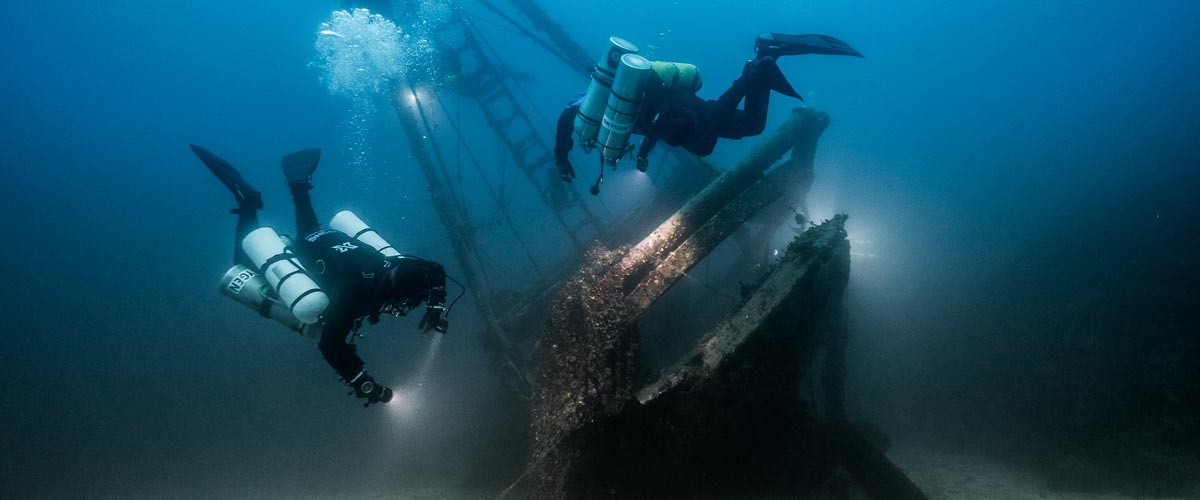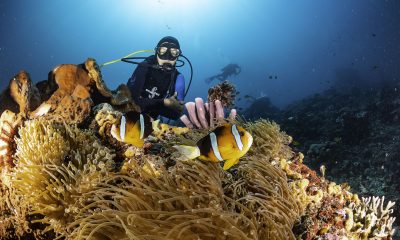Dive Training Blogs
How to Build a Diving First Aid Kit

by Dillon Waters
Whether you are new to the sport or you’ve been instructing divers for years, a first aid kit is something every diver should have on their packing list for each dive. A store with medical supplies is hardly ever within close proximity of a dive site, so packing a useful diving first aid kit is always a good idea. Even when diving with a resort or a liveaboard operation, it’s still wise to bring a first aid kit. It can be the difference between a minor annoyance and something that ends your trip, or worse, threatens your health.
What you should consider before making your first aid kit
The contents of your first aid kit can differ based on the type of diving you do, your training, and any personal medical needs you may have. A diver who prefers to do most of their diving with groups in a resort setting could pack much less than the buddy group going spearfishing from their personal boat. Many diving first aid items require special training to administer such as Oxygen and AEDs. You should seek the proper training before deciding to add these items to your kit. You should also take any personal medical needs into consideration when building a first aid kit. Add extra of any medications you are currently taking and any emergency supplies you may need for an allergic reaction.
What should you pack?
When creating your diving first aid kit, a commercial kit may be a good place to start. Many manufacturers of these kits have sought the expertise of active and experienced divers when building them. Purchasing one of these pre-made first aid kits, such as the Dive 1st Aid Scuba Diver Kit, and adding the items you want or need will increase your chances of having what you need when you need it.
If you’ve decided to build your own diving first aid kit, then it is important to know what you should pack so that you are prepared for the unexpected. Below is a basic list we have put together to assist you:
Storage Container: A waterproof box is recommended due to the increased chance of exposure to water, but not necessary. Choose a container that will best suit your needs. One that is separated into compartments will help you organize the items in your kit, making them easier to find in a first-aid situation. If you prefer to use a container without separate compartments, you can group items into bags to keep them organized.
Basic First Aid Items:
Non-Latex Gloves
5x9in Abdominal Pads
Triangular Bandage
3x3in Sterile Gauze Pads
4x4in Sterile Gauze Pads
Roller Bandage
Adhesive Waterproof Bandages (Assorted Sizes)
Adhesive Cloth Tape
Antibiotic Ointment
Alcohol Wipes
CPR Face Mask
Aspirin (81mg Each)
Ibuprofen Tablets
Acetaminophen Tablets
Space Blanket
Instant Cold Compress
Instant Heat Pack
Scissors or Shears
Tweezers
First Aid Instruction Booklet: In high stress or unfamiliar first aid situations, having a book to reference can help you give the correct care quickly.
Disposable Razor: Can be used to scrape off jellyfish tentacles, etc.
Vinegar: To neutralize the stings of some marine life.
Motion Sickness Medication: If you get motion sickness this is an obvious addition, but for those of you who don’t like seeing others feed the fish off the side of the boat you may want to pack some as well.
EarShield: An oil solution sprayed into the ear pre-dive to repel water while diving.
Ear Beer: A combination of alcohol and vinegar used to dry and clean the ear post-dive.
After you’ve assembled your first aid kit, you will continue to add to it over time as your diving experience increases and you start to learn what you need to include for every dive trip. You should know where each item in your kit is located and you should be able to easily access any part in an emergency. It is also extremely important to open up and check your kit before each trip to ensure everything is there and in working order.
Accidents can happen, so be prepared and dive safe!
To find out more about International Training, visit www.tdisdi.com.

Blogs
Intro to Tech: What is it about?

Article by José Pablo Mir
Pictures by Cezary Abramowski
The world of technical diving is exciting. It opens the door to new sites, depths, and bottom times. More importantly, it opens our minds to a new way of planning, facing, and experiencing dives, even those not purely technical.
Becoming a technical diver is a process, and like in other aspects of life, we should find the proper entry point that suits us best based on our knowledge and experience. The Introduction to Technical Diving course from TDI -the world’s largest and most recognized technical diving teaching organization- is the best option for divers who have yet to gain experience in the fundamental aspects of this new practice. The course’s content and its embrace of new techniques and technologies make it possible to acquire a solid foundation to learn and gain experience in this practice properly.
Becoming a technical diver is not something that happens overnight, whether deciding to become one or receiving a certification card stating we are now technical divers. It is a slow process extending farther away than any introductory course. It requires effort and dedication. But it will bring us satisfaction from day one -or two.
It is a matter of mentality
First, we must understand and accept that technical diving, involving greater depths, longer bottom times, exotic gases, virtual or real ceilings, and more, comes with higher levels of risk than the sport diving we have been practicing until now.
Although this discussion usually starts with a warning about risks, as I’ve done in the previous sentence, our practice is not a game of chance.
Technical diving is a rational activity that requires maturity and good judgment, and we will put everything into ensuring that each dive is a successful one -meaning we return from it safe and sound. With this understanding, we will strive to establish a mental attitude more aligned with our practice and its realities.
This new “technical diver” mindset we will develop will lead us to be more cautious in our executions, more analytical in our plans, more rational in our strategies, and more detailed in our procedures.
Experience will keep teaching us to know ourselves better, to keep our anxiety and other emotions under control, and to manage our impulses. Over time, our senses will sharpen, and we will be more attentive to the particulars of the situation we find ourselves in.

Strategies and procedures
Our strategies, those broad guiding lines tracing the path to follow, from how to approach planning to where, with what, and how we are willing to get there, will be more specific and more practical. Not because they magically become so, but because we will consciously and deliberately frame them that way.
We will establish clear, concise, and realistic procedures. Not only for the undesirable situations that may present themselves but also for those that are part of our dive objectives.
Even though, as technical divers, we often use equipment different from what we were previously accustomed to, it is essential to note that the gear does not make the diver. In a way, we could consider such equipment as the necessary tools to implement what our goal seeks to achieve, according to our strategies and procedures.
Technique plays an important role
We must put our greatest effort into learning and perfecting the different techniques we will be acquiring. Buoyancy, trim, propulsion, cylinder handling, deploying DSMBs and lift bags, valve drills, and more are essential skills we must begin to master to progress in our art. What we cannot do, when we need to do it, can harm us.
Our techniques must be effective and achieve the purpose for which they were devised. But they must also be efficient and require the least resources possible, including the time they take and the effort they demand. Effectiveness and efficiency will prevail over beauty and other considerations that may come to mind, although none of them should be mutually exclusive. A technique executed efficiently and effectively tends to have an inherent beauty.
Refining techniques is a lifelong mission. Some of them will be easy to master from the go; others, on the other hand, will be our life mission and will require many repetitions just to resemble the idea we have in mind of how they should be executed.
We must consider the environment
Our learning, the needs and musts of the practice we engage in, the experience we gradually gain, our strategies and procedures, and even our equipment and tools change with the environment.
Diving in the ocean, everything about us must be suitable for ocean dives. Conditions there rarely emulate those found in a pool, lake, or river. Variable winds and currents, greater depths, visibility conditions, other divers with uncertain skills around us, marine life, maritime traffic, distance from the coast, and many other factors add complexity and uncertainty.
It is never necessary to master the pool on the first day, but planning and aspiring to gradually cope with the ocean’s conditions is essential.
The cost of good training
We are aware that our resources are often scarce in relation to the possibilities of use we could give them if they were not. To a greater or lesser extent, we are part of the economic reality in which we are embedded.
Fortunately, the cost of good technical diver training is not an entry barrier. Comparing training and equipment costs, we see that the former are generally lower. Yes, lower cost for personalized service, essential to our future
performance and safety, than for a series of mass-produced products that are mere, albeit necessary, tools for an end.
The value of good training
The value of the training we received encompasses a range of characteristics, from emotional and methodological to technical and technological. TDI and its Introduction to Technical Diving course offer a deep and modern approach, with a teaching strategy that aims to create thinking divers, not merely obedient ones.
As technical divers, our knowledge is our primary tool. In this type of activity, what we don’t know can harm us.
Is this course optional?
Unfortunately, the fact that this Introduction to Technical Diving course is not a prerequisite for any subsequent training is an invitation to consider it optional. And we all know what usually happens to “optional” under budget constraints.
However, this course should be seen as optional only by those divers who are somehow familiar with the use of technical equipment, who have a mindset more in line with the requirements of this type of diving, who plan and execute the dives the proper “technical” way, who know their gas consumption rate, who are not intimidated by non-decompression tables, who feel comfortable using their dive computers, and know the techniques and have at least an acceptable level of buoyancy, positioning, and propulsion. Those can go straight to a more advanced training course, such as TDI’s Advanced Nitrox.
We must ask ourselves whether or not we are in that group.
Remember our goal: to have fun
Recreational diving is our passion. Jumping into the water carrying heavy equipment and having properly dotted our I’s and crossed our T’s have only one ultimate goal: fun. This is the activity we have chosen as a hobby. We must enjoy it; it must give us pleasure and make us vibrate.
Having a good time is not optional!
Blogs
Four opportunities to go pro in 2024 with Dive Friends Bonaire

Dive Friends teaches the Instructor Development Course (IDC) several times a year to students who are eager to share their passion for diving with the world.
Dive Friends is known for the personal approach throughout the course. Their in-house course director will lead the students through every essential step, mentoring them to achieve their fullest potential as a dive instructor.
Applications for the following IDC start dates are now open:
- 12 April
- 5 July,
- 20 September
- 29 November
Partnership with Casita Palma
If the student opts for the IDC-Deluxe or IDC-Supreme package, their accommodation will be arranged for them at Casita Palma. This small and quiet resort is within walking distance from Dive Friends Bonaire’s main dive shop location and has everything you need to relax after an intense day of IDC training. Breakfast is included, so the student will always be fuelled and ready for their day.
Contact Dive Friends Bonaire’s Course Director Eddy for more information: coursedirector@divefriendsbonaire.com.
-

 News3 months ago
News3 months agoHone your underwater photography skills with Alphamarine Photography at Red Sea Diving Safari in March
-

 News3 months ago
News3 months agoCapturing Critters in Lembeh Underwater Photography Workshop 2024: Event Roundup
-

 Marine Life & Conservation Blogs3 months ago
Marine Life & Conservation Blogs3 months agoCreature Feature: Swell Sharks
-

 Blogs2 months ago
Blogs2 months agoMurex Resorts: Passport to Paradise!
-

 Blogs2 months ago
Blogs2 months agoDiver Discovering Whale Skeletons Beneath Ice Judged World’s Best Underwater Photograph
-

 Gear Reviews2 weeks ago
Gear Reviews2 weeks agoGEAR REVIEW – Revolutionising Diving Comfort: The Sharkskin T2 Chillproof Suit
-

 Marine Life & Conservation2 months ago
Marine Life & Conservation2 months agoSave the Manatee Club launches brand new webcams at Silver Springs State Park, Florida
-

 Gear Reviews3 months ago
Gear Reviews3 months agoGear Review: Oceanic+ Dive Housing for iPhone



















